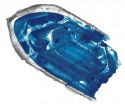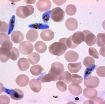(Press-News.org) STANFORD, Calif. - A computerized safety checklist that automatically pulls information from patients' electronic medical records was associated with a threefold drop in rates of one serious type of hospital-acquired infection, according to a study by researchers at the Stanford University School of Medicine and Lucile Packard Children's Hospital Stanford.
The study, conducted in the hospital's pediatric intensive care unit, targeted bloodstream infections that begin in central lines - catheters inserted into major veins. The infections are a preventable cause of illness and death, and hospitals across the country are working to reduce their frequency.
The automated checklist, and a dashboard-style interface used to interact with it, made it fast and easy for caregivers to follow national guidelines for keeping patients' central lines infection-free. The new system combed through data in the electronic medical record and pushed alerts to physicians and nurses when a patient's central line was due for care. During the study, the rate of central line infections in the hospital's pediatric intensive care unit dropped from 2.6 to 0.7 per 1,000 days of central line use.
The findings will be published online Feb. 23 in Pediatrics.
"Electronic medical records are data-rich and information-poor," said Natalie Pageler, MD, the study's lead author. Often, the data in electronic medical records is cumbersome for caregivers to use in real time, but the study showed a way to change that, said Pageler, who is a critical care medicine specialist at the hospital and a clinical associate professor of pediatrics. "Our new tool lets physicians focus on taking care of the patient while automating some of the background safety checks."
Central lines have many uses, such as administering long-term antibiotics or chemotherapy and providing access to the bloodstream in patients who need kidney dialysis or frequent blood draws. The Institute of Medicine's 1999 report on medical errors, To Err is Human, identified central line infections as a key target for reducing harm in health care. Approximately 40 percent of patients in the pediatric intensive care unit have central lines at some point during their hospital stays.
The research team collaborated with engineers from HP Labs to program the checklist and build a dashboard interface that displayed real-time alerts on a large LCD screen in the nurses' station. Alerts - shown as red, yellow or green dots beside patients' names - were generated if, for example, the dressing on a patient's central line was due to be changed, or if it was time for caregivers to re-evaluate whether medications given in the central line could be switched to oral formulations instead.
"The information was visible and easy to digest," said Deborah Franzon, MD, the study's senior author and a clinical associate professor of pediatrics and medical director of the hospital's pediatric intensive care unit. "We improved compliance with best-care practices and pulled information that otherwise would have been difficult to look for. It reduced busy-work and made it possible for the health-care team to perform their jobs more efficiently and effectively."
In addition to avoiding harm to patients, the intervention saved approximately $260,000 per year in health-care costs in the hospital's pediatric intensive care unit, the researchers estimated. Treating a single bloodstream infection from a central line costs approximately $39,000.
The researchers hope to expand the system to other uses, such as monitoring the recovery of children who have received organ transplants.
"The nice thing about this tool is that it's integrated into the electronic medical record, which we use every single day," Pageler said.
Added Franzon, "This system works like a GPS-based road map that pulls relevant information to the forefront, and helps guide decisions about how to get safely to the destination."
INFORMATION:
Other Stanford members of the research team included Christopher Longhurst, MD, clinical associate professor of pediatrics; Matthew Wood, PhD, senior clinical analyst; David Cornfield, MD, professor of pediatrics; and Paul Sharek, MD, associate professor of pediatrics and chief clinical patient-safety officer. Jaap Suermondt, PhD, of HP Labs, also collaborated on the research.
The work was funded by the Lucile Packard Foundation for Children's Health, Stanford's Child Health Research Institute Innovations in Patient Care Program, Stanford's Clinical and Translational Science Award (grant UL1RR025744) and an HP Sustainability and Social Innovation grant.
The Stanford University School of Medicine consistently ranks among the nation's top medical schools, integrating research, medical education, patient care and community service. For more news about the school, please visit http://mednews.stanford.edu. The medical school is part of Stanford Medicine, which includes Stanford Hospital & Clinics and Lucile Packard Children's Hospital. For information about all three, please visit http://stanfordmedicine.org/about/news.html.
Stanford Children's Health, with Lucile Packard Children's Hospital Stanford at its core, is an internationally recognized leader in world-class, nurturing care and extraordinary outcomes in every pediatric and obstetric specialty from the routine to rare, for every child and pregnant woman. Together with our Stanford Medicine physicians, nurses, and staff, we deliver this innovative care and research through partnerships, collaborations, outreach, specialty clinics and primary care practices at more than 100 locations in the U.S. western region. As a nonprofit, we are committed to supporting our community - from caring for uninsured or underinsured kids, homeless teens and pregnant moms, to helping re-establish school nurse positions in local schools. Learn more about our full range of pre-eminent programs and network of care stanfordchildrens.org, and on our Healthier, Happy Lives blog. Join us on Facebook, Twitter, LinkedIn, and YouTube.
Lucile Packard Children's Hospital Stanford is the heart of Stanford Children's Health, and is one of the nation's top hospitals for the care of children and expectant mothers. We are the only children's hospital in Northern California with specialty programs ranked in the U.S. News & World Report Top 10 for 2013-14, and the only hospital in Northern California to receive the national 2013 Leapfrog Group Top Children's Hospital award for quality and patient care safety. Discover more at Discover more at stanfordchildrens.org.
Computerized checklist reduces type of hospital infection, Stanford/Packard study finds
2014-02-24
ELSE PRESS RELEASES FROM THIS DATE:
Children's Mercy physician leads effort to update AAP policy
2014-02-24
KANSAS CITY, MO – February 24, 2014 – With less than half of medications including specific labeling for children, Kathleen Neville, MD, MS, a physician at Children's Mercy Hospital, recently led an American Academy of Pediatrics (AAP) committee in updating the policy with new recommendations guiding the off-label use of drugs in pediatric patients. The policy statement, "Off-Label Use of Drugs in Children," was published online today in the March 2014 issue of Pediatrics.
Dr. Neville is chair of the AAP Committee on Drugs and Director of Experimental Therapeutics in ...
New study settles how social understanding is performed by the brain
2014-02-24
In a study to be published in Psychological Science, researchers from Aarhus University and the University of Copenhagen demonstrate that brain cells in what is called the mirror system help people make sense of the actions they see other people perform in everyday life.
Using magnetic stimulation to temporarily disrupt normal processing of the areas of the human brain involved in the production of actions of human participants, it is demonstrated that these areas are also involved in the understanding of actions. The study is the first to demonstrate a clear causal ...
New process uses recyclable catalyst to create porous materials
2014-02-24
A team of UConn chemists has discovered a new way of making a class of porous materials that allows for greater manufacturing controls and has significantly broader applications than the longtime industry standard.
The process, more than three years in the making, has resulted in the creation of more than 60 new families of materials so far, with the potential for many more. The key catalyst in the process is recyclable, making it a 'green' technology.
"This is definitely the most exciting project I've been involved in over the past 30 years," says Board of Trustees ...
New insights into the origin of birds
2014-02-24
Mark Puttick and colleagues investigated the rates of evolution of the two key characteristics that preceded flight: body size and forelimb length. In order to fly, hulking meat-eating dinosaurs had to shrink in size and grow much longer arms to support their feathered wings.
"We were really surprised to discover that the key size shifts happened at the same time, at the origin of Paraves," said Mr Puttick of Bristol's School of Earth Sciences. "This was at least 20 million years before the first bird, the famous Archaeopteryx, and it shows that flight in birds arose ...
Policies to green the economy must underpin UK recovery: New report
2014-02-24
The UK urgently needs a green economic strategy to move towards low-carbon prosperity, resource security and environmental quality, says a new report published today by UCL's Green Economy Policy Commission.
The Commission – drawn from a range of academic disciplines across UCL – argues that the UK's current situation of climate instability and increasing resource constraints mean that decisive action is urgently needed by the UK government to green the economy.
Greening the Recovery argues that there is a window of opportunity for policies that acknowledge future ...
Mysterious polio-like illness found in 5 California children
2014-02-23
PHILADELPHIA – Researchers have identified a polio-like syndrome in a cluster of children from California over a one-year period, according to a case report released today that will be presented at the American Academy of Neurology's 66th Annual Meeting in Philadelphia, April 26 to May 3, 2014.
"Although poliovirus has been eradicated from most of the globe, other viruses can also injure the spine, leading to a polio-like syndrome," said case report author Keith Van Haren, MD, with Stanford University in Palo Alto, Calif., and a member of the American Academy of Neurology. ...
Scientists transform skin cells into functioning liver cells
2014-02-23
SAN FRANCISCO, CA—February 23, 2014—The power of regenerative medicine now allows scientists to transform skin cells into cells that closely resemble heart cells, pancreas cells and even neurons. However, a method to generate cells that are fully mature—a crucial prerequisite for life-saving therapies—has proven far more difficult. But now, scientists at the Gladstone Institutes and the University of California, San Francisco (UCSF), have made an important breakthrough: they have discovered a way to transform skin cells into mature, fully functioning liver cells that flourish ...
Oldest bit of crust firms up idea of a cool early Earth
2014-02-23
MADISON, Wis. – With the help of a tiny fragment of zircon extracted from a remote rock outcrop in Australia, the picture of how our planet became habitable to life about 4.4 billion years ago is coming into sharper focus.
Writing today (Feb. 23, 2014) in the journal Nature Geoscience, an international team of researchers led by University of Wisconsin-Madison geoscience Professor John Valley reveals data that confirm the Earth's crust first formed at least 4.4 billion years ago, just 160 million years after the formation of our solar system. The work shows, Valley says, ...
Researchers have identified a novel immunological mechanism of great importance for vaccine developm
2014-02-23
Researchers have discovered the presence of a novel subtype of innate lymphoid cells in human spleen essential for the production of antibodies. This discovery, published in the prestigious journal Nature Immunology, clears the path to the identification of novel strategies to develop more efficient vaccines against encapsulated bacteria, considered highly virulent.
This work was done by the B cell Biology research group at IMIM (Institut Hospital del Mar d'Investigacions Mediques) in Barcelona, directed by Dr. Andrea Cerutti, ICREA research professor and leader in the ...
A key protein is discovered as essential for malaria parasite transmission to mosquitos
2014-02-23
Two teams have independently discovered that a single regulatory protein acts as the master genetic switch that triggers the development of male and female sexual forms (termed gametocytes) of the malaria parasite, solving a long-standing mystery in parasite biology with important implications for human health. The protein, AP2-G, is necessary for activating a set of genes that initiate the development of gametocytes -- the only forms that are infectious to mosquitos. The research also gives important clues for identifying the underlying mechanisms that control this developmental ...


